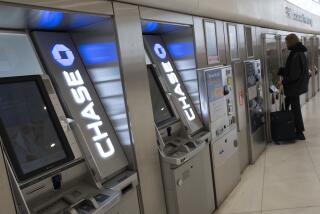No Tax Dollars Needed for Bank Fund, FDIC Says : Finance: Agency chief L. William Seidman believes the banking industry can provide $10 billion to shore up the deposit insurance fund. Lawmakers are skeptical.
- Share via
WASHINGTON — One of the nation’s top bank regulators asserted Thursday that the federal deposit insurance fund, which guarantees bank deposits of up to $100,000, won’t need an infusion of tax dollars, but skeptical lawmakers warned that a bailout may now be inevitable.
In a news conference, L. William Seidman, chairman of the Federal Deposit Insurance Corp., said the banking industry itself should be able to provide the $10 billion officials now estimate the fund will require to avert insolvency.
“At this point, I don’t see any likelihood we will have to go to taxpayers,” he said.
Seidman’s assessment came in a hastily prepared report that he later presented to a meeting of top bankers, who are seeking to draft a plan for the industry itself to bolster the insurance fund. The group hopes to have recommendations ready by the end of February.
But some members of Congress who have wrestled with the costly savings-and-loan bailout are increasingly fearful that the taxpayers will have to come to the rescue of the bank insurance fund as well.
House Banking Committee Chairman Henry B. Gonzalez (D-Tex.) said the banks, which already support the insurance fund by paying premiums, simply cannot provide all the additional money needed to pay for closing crippled institutions.
“I don’t think the resources are there within the industry without endangering some smaller and precarious (banks),” Gonzalez said. He warned that forcing the banks to pay substantially more to the fund could cause the failure of some of the weaker institutions.
Seidman’s assessment was a decidedly more optimistic view than that provided on Wednesday by the Congressional Budget Office. The nonpartisan agency predicted that even if the FDIC increased the premiums it charged, the government still would have to step in.
Rep. Barney Frank (D-Mass.), another Banking Committee member, said he thought the CBO report ultimately would prove realistic. “We’ll get what we can from the banks (to help the fund) and borrow the rest,” Frank said.
Seidman reaffirmed projections that the bank insurance fund may well run dry this year and could require an additional $10 billion to meet its expenses for 1991 and 1992 and avert insolvency.
But he said the money could be financed entirely through higher premiums. And he denied that the deposit insurance fund is on the verge of failure. “There is no crisis here,” he told reporters.
Treasury Secretary Nicholas F. Brady, testifying before the House Banking Committee, offered a similar appraisal. He said any rescue plan should provide enough money from banks “to get the job done” without taxpayer involvement.
He also said the plan should be clearly understandable, with “no smoke and mirrors.” Brady, who also serves on the oversight board for the Resolution Trust Corp., the entity in charge of the S&L; cleanup, asked the committee to approve $30 billion to pay for thrift losses this year.
Separately, Federal Reserve Board Chairman Alan Greenspan told the banking panel that the economy currently is more vulnerable to downturns in consumer confidence than “anything I’ve seen in decades.”
Greenspan said that while most recessions are prompted by excessive buildups of inventories, the current recession seems to have resulted from the reluctance of consumers to spend and the comparative scarcity of credit in the financial system.
He blamed worry about the Persian Gulf War for making consumers hesitant. “We see consumers markedly affected by events in the Middle East,” he said.
Greenspan reiterated previous warnings that if the war persists for a long time, there is a risk that the recession could prove deeper and longer than expected. “Consumer psychology is a major force driving the economy,” he said.
The move by the banking industry to come up with its own rescue plan is motivated partly by self-interest. The bankers want Congress to let them move into the securities and insurance markets, and they realize the chances are scant if a taxpayer bailout is necessary.
Officials from five bank trade associations and such major individual institutions as Bank of America, Chase Manhattan and Chemical Bank held a special meeting Thursday and then conferred with Seidman and Treasury representatives.
The federal officials “wanted very much to have the industry put a proposal before them,” Edward L. Yingling, government relations director for the American Bankers Assn., said after the session.
He said the bankers “are confident that the industry can provide a private sector solution.” The bank trade groups are now working on specific proposals and hope to have a detailed plan ready by the end of February.
Banks now pay 19.5 cents in premiums for every $100 worth of deposits, enough to provide $5.4 billion for the insurance fund this year.
All participants in the search for a safer bank insurance fund agree on one principle: Insured deposits are sacrosanct. The full faith and credit of the Treasury stands behind the government’s pledge to protect deposits up to $100,000.
Such guarantees have reassured savers since the Great Depression and have averted runs on banks and prevented panic, despite scores of bank failures in recent years.
Keeping this pledge for S&L; deposits was costly: Taxpayers will spend at least $130 billion, without counting the cost of future interest payments on bonds, to fill the massive gap between the assets of failed thrifts and the insured deposits of millions of savers.
More to Read
Sign up for Essential California
The most important California stories and recommendations in your inbox every morning.
You may occasionally receive promotional content from the Los Angeles Times.










